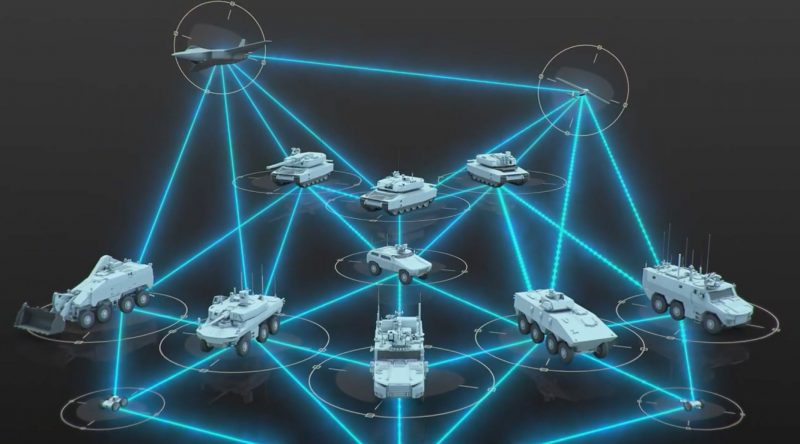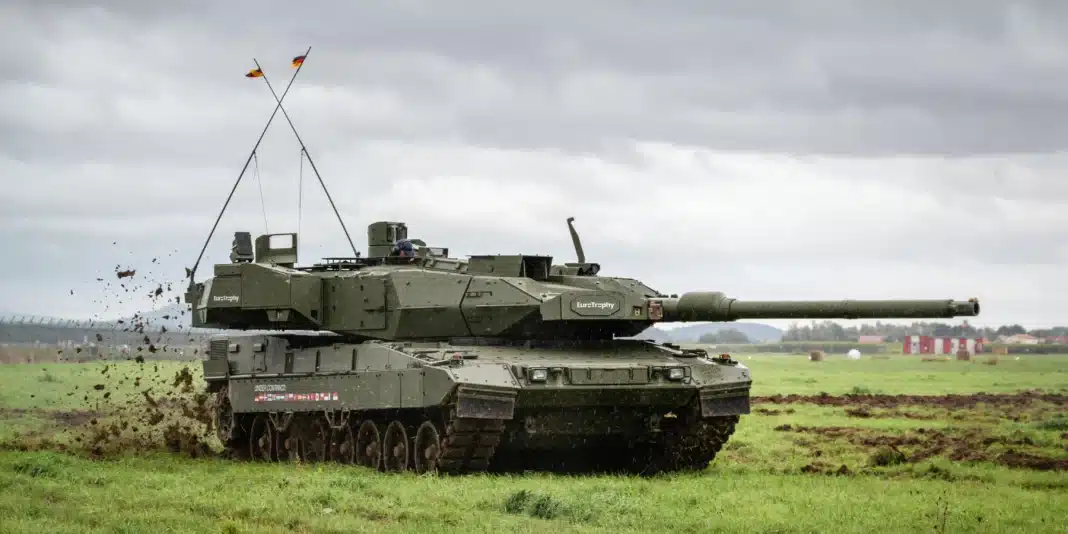The last few days have probably been the most difficult for the Main Ground Combat System, or MGCS, program, initially intended to replace the Leclerc and Leopard 2 from 2035. In fact, in quick succession, several announcements were made across the Rhine, suggesting that this deadline would no longer be respected. So, according to the Bundeswehr, the industrial bottlenecks the program is facing today would now prohibit entry into service in 2035.
Few days ago, Suzanne Weigand, CEO of RENK, which designs and manufactures the very critical transmissions of French and German tanks, declared during an interview that this same deadline was no longer desirable while the immediate demand for new combat tanks comes to redistribute the face of the addressable market in 2035 .
The coup de grace was dealt at the end of the week by Krauss Maffei Wegmann, the designer of Leopard 2, which introduced a new 2A8 version of its tank, and indicated that a more advanced version, still designated 2AX, was in development for entry into service within 2 or 3 years.
The calendar of the MGCS program threatened
Obviously, it will soon be impossible to continue hoping that the first MGCS will replace the French Leclercs and Leopard 2 Germans from 2035, the date of 2045 being often cited across the Rhine.
This deadline is even, from a certain point of view, probably optimistic in view of the reality of the reversal of the market concerning heavy tanks which we are witnessing today in Europe as in the world. As we have mentioned in our previous articles on the subject, such a postponement would harm both the French Army and the National Defense Land Industrial and Technological Base.
The first, in fact, does not currently have the possibility of reinforcing or modernizing its Leclerc fleet as it should to reach such a deadline, or at least nothing indicates to date in French military programming that the hypothesis has been treated as a whole. The second, for its part, has an optimized load plan with the SCORPION program taking it to 2035, and counted on the TITAN program, of which MGCS is the main pillar, to take over at this time.

In fact, if, as is now very likely, the MGCS program were to be postponed without being cancelled, it will be necessary for Paris to find an interim solution capable of simultaneously meeting the needs of the Army as well as those of the BITD on land, so as to preserve the capacities and ambitions of both.
Towards an interim solution for the Army
Several articles published on this site have already studied a few options, such as the EMBT demonstrator and its very promising turret developed by Nexter, or even by turning to an exogenous solution, like the KF51 Panther by Rheinmetall, the Polish K2PL or the new Leopard 2AX currently being designed at KMW, Nexter’s partner within the KNDS group.
However, these analyzes were based on the study of an existing solution, to determine its relevance and sustainability in the event of an increase in format, and not to respond to a postponement of MGCS. In this article, on the contrary, we will start from the needs, from the international and commercial context, but also from the lessons of the War in Ukraine on this subject, to establish what would be the best response that the French BITD could provide.
Only a few years ago, most staffs considered the battle tank to be a relic of the past. For many, the advances made in recent decades in anti-tank ammunition, but also in prowling ammunition and precision artillery or airborne ammunition, made the tank too vulnerable to play its role on the battlefield. The examples of post-Cold War engagements, notably in Chechnya, Iraq or Afghanistan, tended to confirm this perception.

The rest of this article is for subscribers only
The Classic subscriptions provide access to
all articles without advertising, starting at € 1,99.
Newsletter subscription
Register for the Meta-Defense Newsletter to receive the
latest fashion articles daily or weekly


Bravo, an article of strategic importance!
THANKS )
As always very stimulating. To be completed with an economic analysis. France has not planned a massive battle corps. At most a few hundred units, which makes it illusory to make a program of such magnitude profitable. It seems to me that in your previous articles, you mentioned the possibility of buying a base (engine, transmission, etc.) from the Germans and supplementing it with French elements (turret, gun, electronics, etc.). Failing to make the same tank, why not share common bricks which would be amortized over longer series and build two different products (German heavy, French medium)
The problem is that the Germans are advancing very quickly and on their own on this subject. They have no interest in developing a “complementary” range or even in supporting its emergence. Some parts, like the transmission (Renk) and probably the engine (MTU), will be German anyway. But to increase budgetary sustainability, it seems to me more relevant to count on other potential partners. It should not be forgotten either that the aim is precisely to preserve industrial skills, which today are clearly threatened by the evolution of the MGCS programme.
Why not stay on a 45 ton machine with a heavy combat version (140mm Ascalon system + 25mm teleoperated cannon) and an infantry combat version (50% teleoperated CTA 40mm turret + missiles – 50% teleoperated heavy machine gun turret and lance 40mm grenade + rockets) for breakthrough and urban combat?
And keep for the bulk of the forces the 8-ton 8×30: support version (with a remotely operated 120mm turret + 25mm cannon) and infantry combat version (50% remotely operated CTA 40mm turret + missiles – 50% remotely operated turret heavy machine gun and 40mm grenade launcher + rockets)
Keeping reasonable masses for operative mobility (thanks to active protections) and having common chassis for the "tanks" and "VCI" of each class allows economies of scale and control of acquisition costs, MCO and logistical needs.
Heavy MBTs are mostly relevant currently for countries in NATO marches, or for lack of alternatives. But what operative mobility and job prospects for these MBTs stationed in France, Spain, the UK…? And to intervene if necessary elsewhere than on the "eastern front"? Let's stop preparing for the previous or current war and turn to the foreseeable needs. Let's leave this heavy panzer market to the Germans.
It seems to me that many countries would find an advantage in this model (India in particular) to finance development or later to equip their forces.
140 mm and 45 tons… not sure it works. It is possible in tank destroyer version but the war in Ukraine showed precisely that this approach which one can qualify as conservative, posed real problems because armored vehicles do not have the required mobility. One can also wonder about the added value of a 140 mm tube when the vast majority of engagements are made at less than 1000 m, a distance at which a 105 HP is sufficient to pierce almost anything. A 105 lighter and faster in rate of fire as in angular velocity seems to me to respond much better to the lessons of the war in Ukraine.
Regarding the caliber suitable for the top of the firepower spectrum, Nexter suggests that its Ascalon solution would be suitable for vehicles weighing less than 50 tonnes by 2025, with telescoped ammunition for direct or indirect fire. (if that doesn't work we can keep the 120mm, which should keep a good efficiency up to 2000 meters.) I am quite reserved on the idea of basing our military model for the next 20 years on observations in Ukraine, at the risk to have a late war as usual… I hope that we are considering a more dynamic approach to gain the upper hand at the start of a conflict over a possible adversary. There are vast plains in Europe, North Africa and the Middle East where a necessarily restricted contingent of Western armor would be relieved to take advantage of firepower and superior reach to defeat (without air superiority) masses of MBTs of varied origin. I sincerely hope that we never have to intervene against a China-invigorated and equipped Russia, or against Algeria, Egypt, Saudi Arabia, Turkey, Iran or a Chinese expeditionary force in an area of major interest, but that's what you have to be prepared for. I imagine that in urban combat the 140mm with adapted shells can certainly render great services. On the contrary, a 45 ton tank to carry a simple 105mm HP seems to me a little oversized compared to its added operational value, even if that would make the ammunition allocation and the autonomy in combat more comfortable.
[…] […]
And why not the Japanese type 10, a modern tank more compact than the Leclerc, weighing 40 to 48 tons depending on the modular armor carried.
The cost of francization would be much lower than an R&D effort, and would be equipped with French weapons and electronics.
An opportunity to engage in cooperation with Japan.
[…] total industrial and partially operational in the field of heavy tanks, could be based, as we have already mentioned, on the design of an armored combat vehicle dedicated to high or very high intensity, without […]